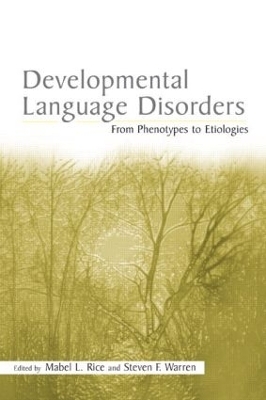
Developmental Language Disorders
Psychology Press (Verlag)
978-0-8058-4662-1 (ISBN)
Developmental Language Disorders: From Phenotypes to Etiologies is based on the recent conference of the same name sponsored by the Merrill Advanced Studies Center of the University of Kansas. In the past 10 years, considerable advances have taken place in our understanding of genetic and environmental influences on language disorders in children. Significant research in behavioral phenotypes, associated neurocortical processes, and the genetics of language disorders has laid the foundation for further breakthroughs in understanding the reasons for overlapping etiologies, as well as the unique aspects of some phenotypes. Too often the findings are disseminated in a fragmented way because of the discrete diagnostic categories of affectedness. This volume attempts to assimilate and integrate the findings of the transdisciplinary research toward a more coherent picture of behavioral descriptions, brain imaging studies, genetics, and intervention technologies in language impairment. The contributing authors are all scholars with active programs of research funded by the National Institutes of Health involving diverse clinical groups of children with language impairments.
Mabel L. Rice (Edited by) , Steven F. Warren (Edited by)
Contents: M.L. Rice, S.F. Warren, Preface. M.L. Rice, S.F. Warren, Introduction. Part I:Phenotypes of Language Impairments Within Clinical Diagnoses.C. Lord, S. Risi, A. Pickles, Trajectory of Language Development in Autistic Spectrum Disorders. H. Tager-Flusberg, Do Autism and Specific Language Impairment Represent Overlapping Language Disorders? J.B. Tomblin, X. Zhang, A. Weiss, H. Catts, S.E. Weismer, Dimensions of Individual Differences in Communication Skills Among Primary Grade Children. L. Abbeduto, M.M. Murphy, Language, Social Cognition, Maladaptive Behavior, and Communication in Down Syndrome and Fragile X Syndrome. A. Zukowski, Investigating Knowledge of Complex Syntax: Insights From Experimental Studies of Williams Syndrome. D.B. Bailey, Jr., J.E. Roberts, S.R. Hooper, D.D. Hatton, P.L. Mirrett, J.E. Roberts, J.M. Schaaf, Research on Fragile X Syndrome and Autism: Implications for the Study of Genes, Environments, and Developmental Language Disorders. Part II:Investigating Language Impairments Across Diagnostic Categories.C.B. Mervis, Cross-Etiology Comparisons of Cognitive and Language Development. S.F. Warren, Intervention as Experiment. M.L. Rice, Growth Models of Developmental Language Disorders. C. Phillips, Linguistics and Linking Problems. Part III:Neural, Genetic, and Behavioral Elements of Inherited Factors.R-A. Müller, Genes, Language Disorders, and Developmental Archaeology: What Role Can Neuroimaging Play? S.D. Smith, Localization and Identification of Genes Affecting Language and Learning. C.A. Morris, Genotype-Phenotype Correlations: Lessons From Williams Syndrome Research. Part IV:Research Action Steps for the Short and Long Term.P. McCardle, J. Cooper, Next Steps in the Study of Genetics and Language Disorders.
| Erscheint lt. Verlag | 16.7.2004 |
|---|---|
| Verlagsort | Philadelphia |
| Sprache | englisch |
| Maße | 152 x 229 mm |
| Gewicht | 703 g |
| Themenwelt | Medizin / Pharmazie ► Medizinische Fachgebiete ► Neurologie |
| Medizin / Pharmazie ► Medizinische Fachgebiete ► Pädiatrie | |
| ISBN-10 | 0-8058-4662-X / 080584662X |
| ISBN-13 | 978-0-8058-4662-1 / 9780805846621 |
| Zustand | Neuware |
| Haben Sie eine Frage zum Produkt? |
aus dem Bereich


